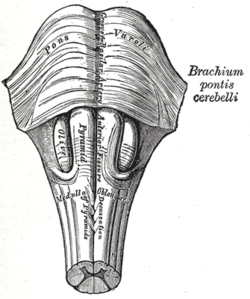Pons
| Pons | |
|---|---|

Diagram showing the positions of the three principal subarachnoid cisternae (pons visible at center)
|
|

Anteroinferior view of the medulla oblongata and pons
|
|
| Details | |
| Part of | Brain stem |
| Artery | pontine arteries |
| Vein | transverse and lateral pontine veins |
| Identifiers | |
| MeSH | A08.186.211.132.810.428.600 |
| NeuroNames | hier-538 |
| NeuroLex ID | Pons |
| TA | A14.1.03.010 |
| FMA | 67943 |
|
Anatomical terms of neuroanatomy
[]
|
|
The pons is part of the brainstem, and in humans and other bipeds lies between the midbrain (above) and the medulla oblongata (below) and in front of the cerebellum.
The pons is also called the pons Varolii ("bridge of Varolius"), after the Italian anatomist and surgeon Costanzo Varolio (1543–75). This region of the brainstem includes neural pathways or tracts that conduct signals from the brain down to the cerebellum and medulla, and tracts that carry the sensory signals up into the thalamus.
The pons in humans measures about 2.5 centimetres (0.98 in) in length. Most of it appears as a broad anterior bulge rostral to the medulla. Posteriorly, it consists mainly of two pairs of thick stalks called cerebellar peduncles. They connect the cerebellum to the pons and midbrain.
The pons contains nuclei that relay signals from the forebrain to the cerebellum, along with nuclei that deal primarily with sleep, respiration, swallowing, bladder control, hearing, equilibrium, taste, eye movement, facial expressions, facial sensation, and posture.
Within the pons is the pneumotaxic center consisting of the subparabrachial and the medial parabrachial nuclei. This center regulates the change from inhalation to exhalation.
The pons is implicated in sleep paralysis, and may also play a role in generating dreams.
The pons can be broadly divided into two parts: the basilar part of the pons, located ventrally, and the pontine tegmentum, located dorsally.
...
Wikipedia
